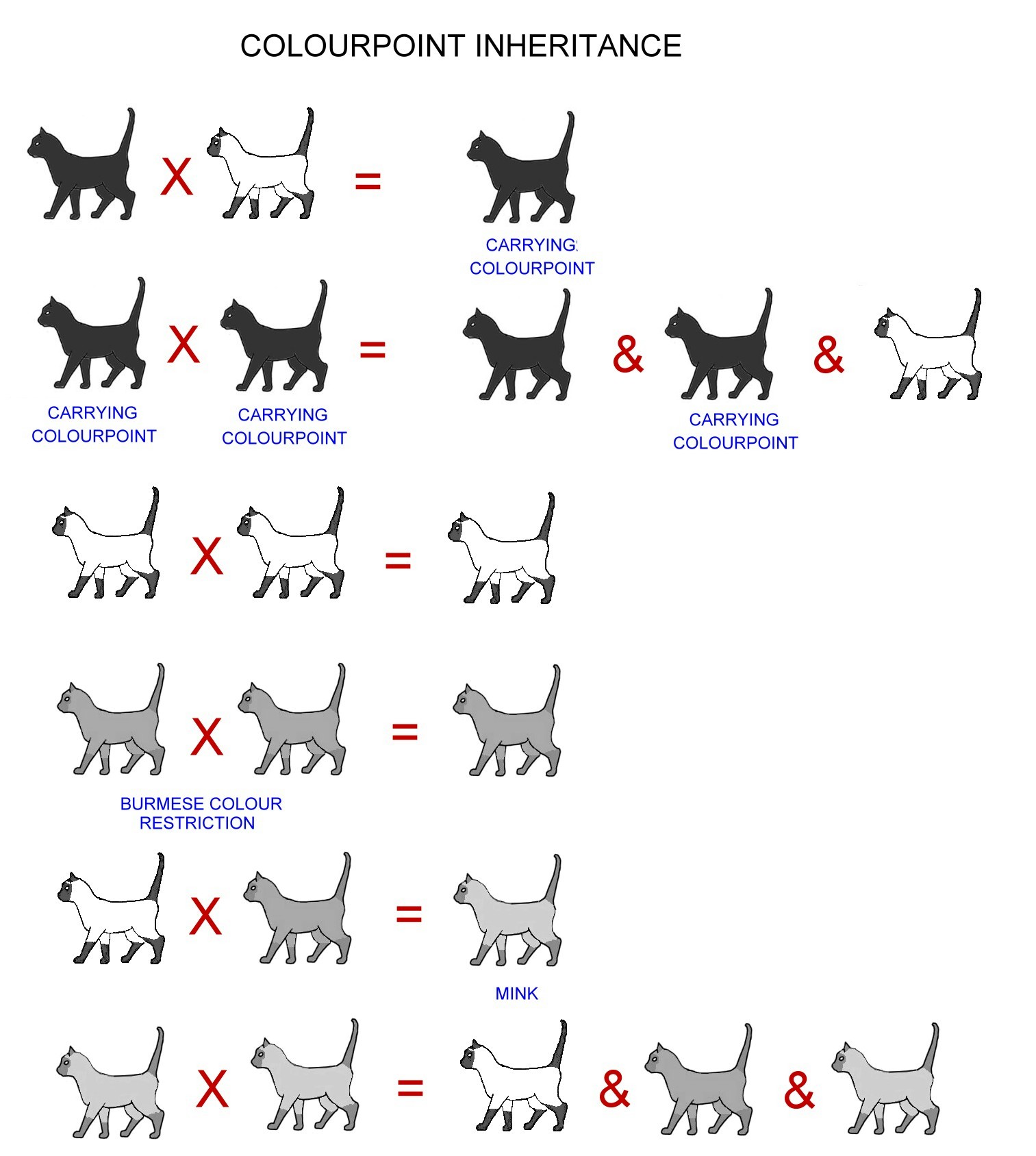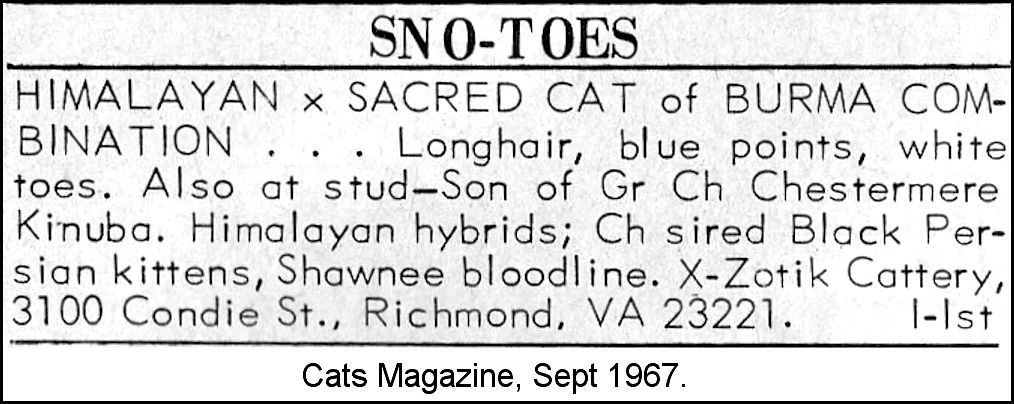
COLOURPOINTED CATS - SNOWSHOE, TONKINESE, NEVA MASQUERADE, OPAL, MASKED SILVER AND CROSS-BREEDS
The colourpoint pattern is a form of albinism and is known as the "Himalayan pattern" (often called "Siamese" pattern by cat lovers). It is found in several mammals including rabbits and goats from the Himalayas region. The exact effect of the gene depends on the temperature since its effect is inhibit colour in warm areas of the body and allow colour to develop on the cooler areas such as the ears, face, legs, tail and (in males) scrotum. In warmer climes, there is less contrast between the body colour and the point colour. Colourpoint kittens are born with almost pure white coats on a pink skin because of the uniform warmth in the womb; only after birth does the point colour develop. In cooler regions, the contrast may be very pronounced. The characteristic blue eyes reflects reddish at night because albinism affects the tapetum (reflective layer) of the eye; non-albino cats' eyes reflect greenish. The most familiar colourpoint breeds are the Siamese and Himalayan (Colourpoint Longhair/Colourpoint Persian), but there are a number of others. Most, if not all, colourpoint cats have Siamese somewhere in the history, or at least have Thai, Asian or Japanese cats in the family tree since this pattern occurs naturally throughout Asia and into Russia. The Burmese has a "low contrast" form of the colourpoint gene andthe Tonkinese is halfway between Burmese and Siamese. There are a series of gene variants and combinations controlling the contrast between body colour and point colour.
SNOWSHOE, SNOWSHOE SIAMESE AND SNOW-TOES
Originally, the Snowshoe (or Silver Laces Cat) resulted from crossing Siamese, or Oriental Shorthairs, with American Shorthairs. The white mitts occur natually in some lines of Siamese where they are considered a fault. Today Snowshoes generally result from Snowshoe to Snowshoe breedings although they may still be outcrossed to one of the founding breeds in order to expand their gene pool, introduce new colours, or improve type or colour/pattern. Officially the breed claims no Birman ancestry despite the superficial resemblance in pattern. Snowshoes were developed in the USA by Dorothy Hinds in the late 1960s when her two Siamese cats produced kittens each with four white feet. White spotting sometimes showed up in early Siamese cats (white toes are occasionally still found). She dubbed them Snowshoes. The variant did not recur so she crossed a Siamese with a bicolour American Shorthair. In addition to the white mitts, this eventually produced the inverted white 'V' on the face. The Snowshoe was recognised by various American registries in 1974, however in 1977 there was only one registered breeder of Snowshoes. Luckily, interest in the breed picked up and the Snowshoe has become a popular breed in the USA. It has Siamese style points and blue eyes combined with white paws and white spotting and comes in blue, seal, lilac and chocolate points. The Snowshoe pattern is divided into two categories: Bicolour Snowshoes where up to two-thirds of the cat can be white and Mitted Snowshoes where the white ranges from just the toes to halfway up the leg. Snowshoes have a white inverted 'V' extending from between the eyes down over the nose. The Snowshoe conformation is intermediate between the parent breeds and is sometimes described as close to the older (or traditional) and more moderate style of Siamese cat although it is sometimes described as resembling the American Shorthair. The Snowshoe inherits the muscular body from the American Shorthair and the body length from the Siamese/Oriental. The conformation is, to some extent, affected by the outcross breeds permitted in countries where the American Shorthair is not found.
Early on the breed was erroneously thought to be a Birman Shorthair, based purely on its appearance. The Birman Shorthair (Templecat) only came into existence in 1995 in New Zealand.
In the 21st Century, an experimental breed called the Snowshoe Siamese was announced. Its body type is more extreme and is closer to the modern Siamese, while the original Snowshoe maintains the more moderate body type. Some Siamese cats have appeared with white toes and this was considered a serious fault in the breed so it was not met with enthusiasm by the mainstream cat fancy.

The Snow-Toes was bred in the late 1960s by crossing Birmans to Himalayans, seemingly with the aim of a mitted Himalayan, or to widen the Birman gene pool. Whether this will see a revival alongside the Snowshoe Siamese has yet to be seen.
NEVA MASQUERADE
In 1990, the first Siberians were imported into the USA. However the colourpointed variety with blue eyes was not imported and colourpoint Siberians were not recognised by registries on in American breed standards. However Russian breeders have recognised the colourpointed variety since they began to keep records (in around 1987). According to anecdotes, colourpointed feral cats bred with feral Siberian cats along the banks of the Neva river at St Petersburg (then Stalingrad). The name Neva Masquerade reflects the origins of this masked cat.
The first Siberian cats were imported into the USA in 1990 by Elizabeth Terrell of Louisiana, in exchange for Himalayan cats sent to establish that breed in Russia. The first colourpoint Siberians were imported into the USA in 1997 and registries are have recently accepted it following early controversy.
TONKINESE
The Tonkinese is intermediate in type between Burmese and Siamese. Its pointed pattern is less pronounced than that of the Siamese and its shape is less extreme. Long known as a variety in Thailand, it has existed in the West for at least a hundred years. Towards the end of the 1800s, a cat described as a chocolate variety of Royal Siamese was exported from Singapore to England. It was a rich chocolate colour with a darker face, ears and tail; and its legs were darker than the body. It was not, however, recognised as anything other than a brown Siamese and interest in them had waned because it had been hard to compete against the striking coat and eye colour of the Siamese. These cats were either Burmese or Tonkinese, or most likely a mix of both types since some, when bred to the royal Siamese, produced offspring with "poor" markings (i.e. "mink") while others evidently produced offspring had royal Siamese markings. In 1903, the "Burmese Cat" (shown here) would be, in modern terms, an Oriental Ticked Tabby!
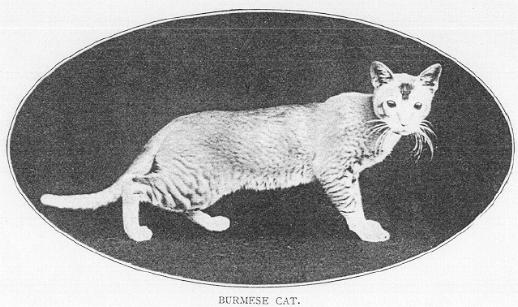
The Tonkinese is considered a hybrid of Siamese and Burmese and this has hindered its acceptance in some countries e.g. Australia because "as a hybrid it cannot breed true". The alternative standpoint is that it is that Tonkinese is the naturally occurring intermediate form of a colour range where the two extremes are represented by Siamese and Burmese. The two extreme forms have been selectively bred, but the intermediate form was ignored until relatively recently. Tonkinese type cats have been described for many years: the Chocolate Siamese (Britain, 1880s; generally considered to be Burmese), Golden Siamese (USA, 1950s, Siamese/Burmese hybrids),Golden Chechongs, Si-Burms and Zibelines (the French name for Burmese). These all had tan to brown bodies with seal or almost black masks and points.
The self-coloured Chocolate Siamese (as opposed to the Chocolate Point Siamese) was described by Harrison Weir in 1889 and by Frances Simpson in1903, however the "Royal Siamese" with its greater contrast between body and points was the form that predominated in Britain and the Chocolate Siamese was lost. The Chocolate Siamese is variously claimed to be an early Burmese or an early Havana Brown type cat. The founding female of the Burmese breed, Wong Mau, was a walnut-brown Tonkinese type cat imported into the USA from Rangoon in 1930. She was described as brown with darker points on her face, legs, feet and tail. When bred to a seal-point Siamese, she produced kittens identical to herself and some with a Siamese coat pattern. Over several generations and through mating her to her own sons, three varieties of offspring arose: those with a Siamese pattern, those which were dark brown all over (Burmese) and those with a dark brown body but identifiable darkening at the points much like Wong Mau herself. Wong Mau is considered to be the founding mother of the Burmese breed but was herself a Tonkinese and breeders chose to develop her Burmese offspring.
In the early 1940s, a Hawaiian breeder, Lelia Volk, bred a dark variety of Siamese: its colour was lighter than the Burmese, but darker than the Siamese. In a report in the Journal of Heredity, the colour was said to be close enough to the Siamese that it was unlikely to be perpetuated. Between the 1950s and early 1960s, Milan Greer in New York City bred Golden Siamese. These were Siamese/Burmese hybrids which had a rich mahogany body and dark points. Greer had been told that such cats were normally considered defective and destroyed because they did not breed true. Using Seal Point Siamese and Sable Burmese and cross-breeding their offspring, he produced chocolate brown cats with darker points and claimed to have bred pure "Golden Siamese" for 5 generations. Having proven his point, he stopped breeding, though his cats were popular with pet buyers.
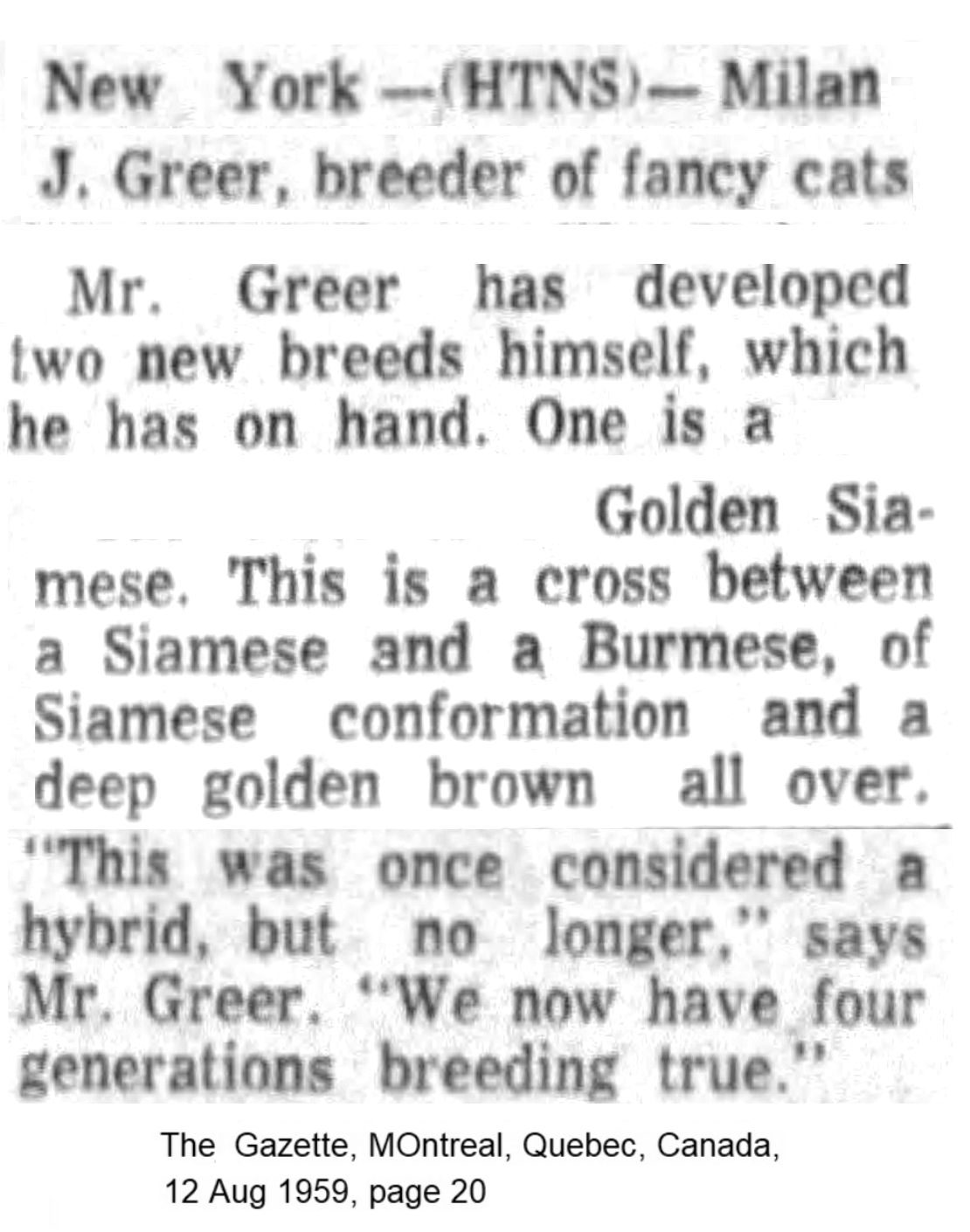
In the 1960s and 1970s, the Tonkinese was revived in Canada and the USA by crossing Siamese with Burmese in spite of opposition from breeders of both Siamese and Burmese who viewed them as embodying everything they were trying to breed out of those two breeds. In the mid 1960s, Jane Barletta of New Jersey switched from the increasingly extreme Siamese to breeding the more moderate Tonkinese. At about the same time, Margaret Conroy in Canada bred a female Burmese to a Seal point Siamese as she was unable to find a suitable Burmese stud in her locality. Her tan-bodies cats bred true for 5 generations and were dubbed Tonkanese (with an "a"). The original cats were Sable (US: Natural Mink), but crosses between Blue Burmese and Blue Point Siamese introduced Blue Tonkinese. Later on, the other Siamese/Burmese colours were also bred together to expand the Tonkinese colour range: red, lilac (US: platinum), chocolate (US: champagne) and cinnamon (US: honey).
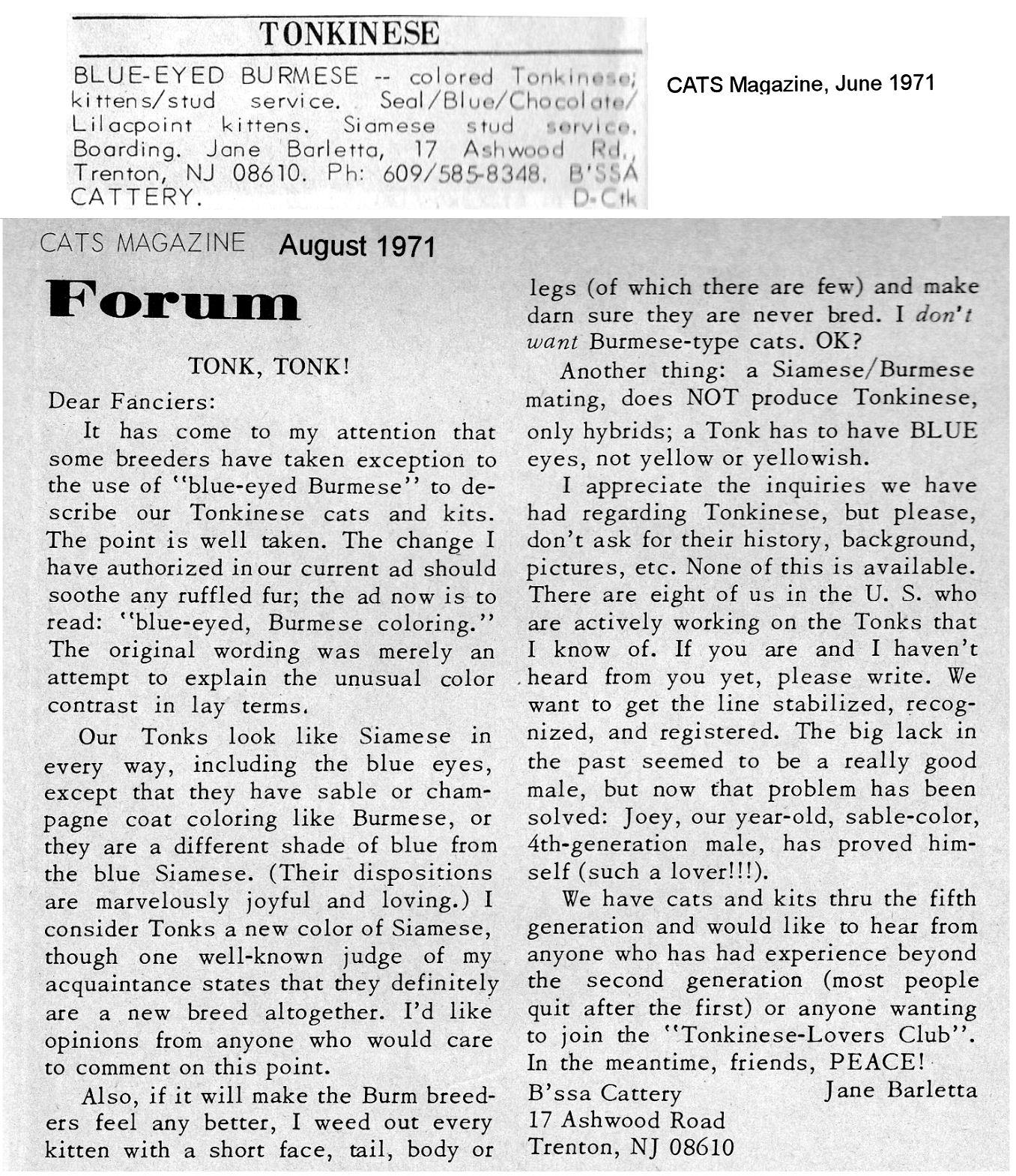
Though the Tonkinese breed in the USA has been recreated by crossing the Siamese and the Burmese, the variety has occurred naturally in south east Asia for hundreds of years. Rather than being a hybrid, it is a naturally occurring breed and the Burmese, Tonkinese and Siamese represent the two extremes and the mid-point of an overall genetic pattern caused by 2 mutant genes. Recognition in various cat fancying countries came from the 1980s onward. In the UK, it was recognised in 1990. In Australia it was grudgingly accepted in the 1990s despite being condemned as a hybrid and unable to breed true.
The colours of Tonkinese are (the term "mink" is not used by some registries) blue mink, champagne mink (light chocolate), honey mink (chocolate/chestnut), natural mink (seal), platinum mink (lavender/lilac), red mink, cinnamon mink, fawn mink, cream mink. In some registries Burmese are accepted in tortie patterns and this will be reflected in the Tonkinese. Its genetic make-up means that Tonkinese-to-Tonkinese breedings will always produce a mix of patterns: self (Burmese-type) variants, Tonkinese and colourpointed variants. The colourpointed Tonkinese find favour with those who seek a less extreme version of the Siamese. Although most registries don't accept the variants for exhibition, the variants are an important part of the breeding program; bred together they produce Tonkinese-pattern cats.
COLOURPOINT SHORTHAIR (COLOURPOINT BRITISH SHORTHAIR)
|
|
|
The Colourpoint British Shorthair is exactly what the name suggests - a British Shorthair in a colourpoint coat with blue eyes. It was developed in the 1980s by crossing the British with the Himalayan.
Mink is a pointed pattern intermediate between Burmese colour restriction (sepia) and colourpoint; all basic colours and patterns can have a mink version. The mink pattern was introduced into the British Shorthair in France, with the first French-bred Mink British Shorthair being born in 1995. The preferred eye colour is aqua (blue-green), but it can range from yellow-green to blue-green depending on the base colour. In Russia, the sepia gene entered the British Shorthair in 2017 from the Scottish Straight (straight eared variant of Scottish Fold); Scottish Folds are outcrossed to British Shorthairs to maintain health), resulting in both sepia and mink British Shorthairs. Mink occurred because colourpoint British Shorthairs were already recognised. Mink British Shorthair are bred by Tatyana Rechkina of Fluffy-cats Cattery. This line of sepia and mink is completely independent of the French cats. The sepia gene entered the Russian-bred Scottish Fold/Straight gene pool in the USA from crossing to American Shorthair(s) which had gained the sepia gene via the Bombay breeding programme in the 1950s/60s. Some of the first sepia Scottish Folds were at Rumfold cattery, but the breeder did not pursue the colour, instead selling sepia carriers to other catteries. Because the mink cats had been bred from lines selected for deep copper eyes, the eye colour was not the desired aqua colour. Several Russian catteries now have sepia and mink Scottish Folds/Straights and sepia and mink British Shorthairs, and some have bred golden minks/sepias, silver minks/sepias and copper minks/sepias. (Copper is an extreme expression of golden/rufism where the coloured tipping is so minimal that the cats appear copper coloured).
OPAL (COLORPOINT AMERICAN SHORTHAIR)
In the 1990s, breeders of appleheaded (roundheaded) Siamese were invited to register their cats as Opals. Little has been heard of the Opal since then although the traditional style of Siamese goes from strength to strength (despite the registry's rather bizarre refusal to allow its actual breed name to be used in articles or reviews in case it erodes, rather than promotes, the breed). The Opal appears to be a Colourpoint American Shorthair.
THAI POINTED AND THAI SIAMESE
The Thai Pointed is a naturally occurring colorpointed (Blue-point, Lilac-point) Korat variant. Korats are related to Siamese and have interbred naturally in their native Thailand.
The Thai Siamese is a European term for the traditional style of Siamese derived purely from non-ultra-typed Siamese cats.
The term Thai Siamese has also been used for colorpointed cats derived from naturally occurring colorpointed variants in Korat litters, but this usage is not encouraged.
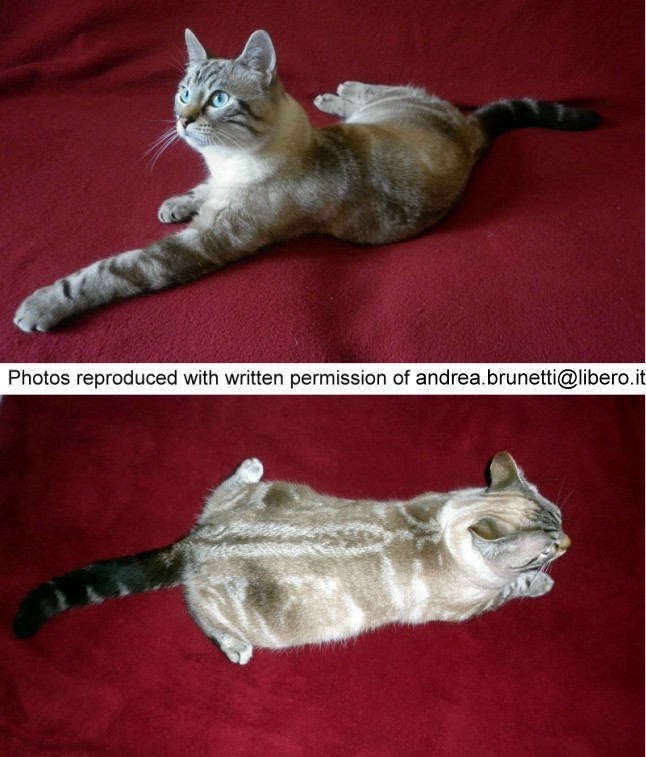
Andrea and Beata Brunetti, in Italy, have a Thai (the European name for the less extreme, traditional or old style of Siamese cat) called Urban Hunter with a visible blotched tabby pattern and an interesting dorsal stripe. Urban Hunter has been mated to a red-point Thai called Kasia Ruda, resulting in one male and four female kittens. All of these have dorsal stripes similar to Hunter.
In some lines of old type Siamese, there is less contrast between body and points. The Siamese pattern is caused by an albinism gene, but is partly dependent on temperature, with a darker colour developing in cooler regions. This is unlikely as Urban Hunter lives in a climate where the temperature ranges between 25 and 30 celsius.
Polygenes can also help to allow or suppress the colour. Variable contrast between body and points is seen more often in the older style Siamese, probably due to greater genetic diversity compared to the modern extreme-type cats. It is also possible that a novel mutation has occurred as Urban Hunter has aqua, rather than Siamese blue, eyes. Because of the aqua-blue eyes, I initially wondered if Urban Hunter had Tonkinese in his ancestry (Tonkinese is intermediate between Siamese and Burmese in colourpoint). Genetic testing and test-mating would be required to determine whether Hunter s colouring is due to a mutation of the colourpointing gene.
PIKA BUE (SHORTHAIR AND SEMI-LONGHAIR)
The Pika Blue is a colourpointed variant of the Russian Blue and Nebelung. The colourpoint variants arose naturally in Russian Blue and Nebelung litters in the 21st century as a result of emergency crossbreeding in the early 1940s. During, and immediately after, the Second World War, the Russian Blue was in danger of extinction in Western Europe. In order to save the bloodlines, cats were bred to blue-point Siamese with the intention of selectively breeding back to the Russian Blue standard later on (e.g. using imported cats that had never been crossed to Siamese) and eliminating the colourpoint gene. As a result of the outcrossing, the colourpoint gene lurked in some bloodlines until the present day. Because colourpoint is recessive, it remained hidden, but if two carriers were mated together it was possible to get blue-pointed, blue-eyed, Russian Blue kittens. This often led to the colourpoint-carrying parents being removed from the gene pool to prevent further spread of the colourpoint gene.
At Cattery Ladoga, in the Netherlands, a number of blue points were born: a colourpointed male from Russian Blue parents in 2013; two blue-point Nebelugs from the same Russian Blue female and a Nebelung male in 2014; a blue Nebelung male from a Russian blue female and Nebelung male in 2015; and a blue-point Russian from a Russian Blue female and Nebelung mle in 2016. In 2015, it was decided to breed and acknowledge the cats, under the name Pika Blue, and a search began for a suitable blue-point stud cat as none was available in the Netherlands. So much interest was generated that several catteries united together to breed the Pika Blue in a controlled manner.
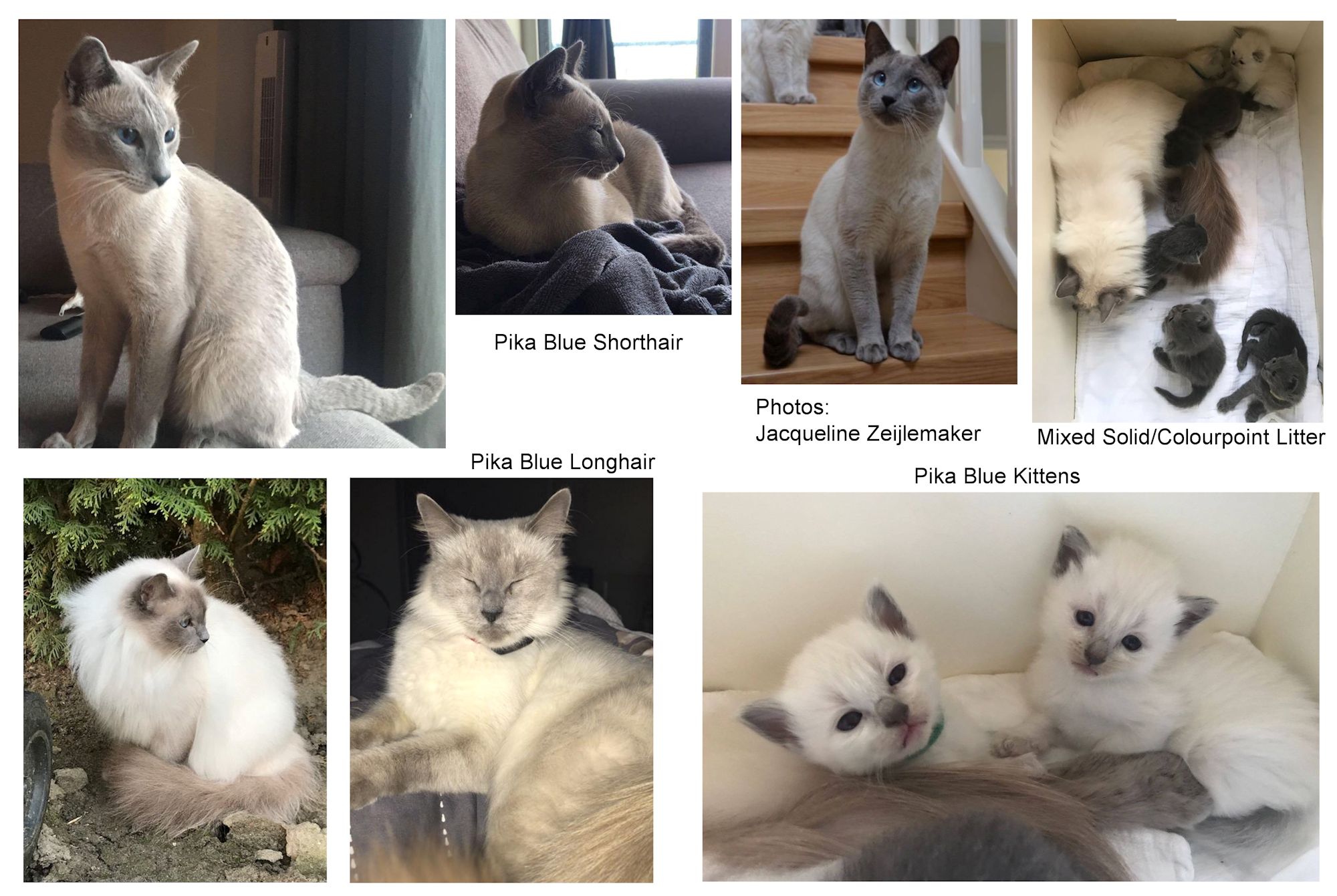
How did the colourpoint gene get into the Russian Blue gene pool? Perhaps the best documented crosses of Siamese and Russian Blues were those made by A. Hargreaves, F.Z.S and described in Our Cats magazine in October 1951 and June 1952. Early in 1948 Mrs Hargreaves decided to carry out some breeding experiments with Siamese cats, the principal object being to establish a more robust strain. There was a prevailing opinion among the public that Siamese kittens were not as strong as others, and many reportedly did not reach maturity. Hargreaves felt sure that hereditary factors, as well as environmental ones, were involved. Because hardiness may be established in animal breeding by using a good outcross, Hargreaves chose that method, carefully selecting an outcross pedigree stud with no undesirable factors such as white spotting.
No Black Shorthair stud was available at that time so the chosen stud was a Russian Blue, and she sent her Siamese queen, Laurentide Ludo, to be mated to Champion Silvershoen Blue Peter. Ludo produced 8 black Shorthair kittens, and Hargreaves let her rear 2 males and 4 females, all strong and healthy. These hybrid Siamese all carried the colourpoint gene from their dam, and the dilution (blue) gene from their sire. When mated back to Siamese the resultant litters on the average should contain half Black Self and half Siamese [i.e. half colourpoint]. When backcrossed to a Russian Blue they should produce Black Self and Blue Self.
The black hybrid male, Laurentide Eclipse, was mated in turn to two of his sisters, and three of those were also backcrossed to Siamese. The table shows the matings and the number and breed [what the 21st Century breeder would call colour] of the offspring. A few offspring were Siamese in colour but not in build. On the other hand, Hargreaves did not lose conformation, as proved by the photographs of Jade, and the fact that she won several awards. Meanwhile the Russian Blue, Sene, won two Firsts in Open Classes and Best in Show (ex Siamese) as a kitten. Later litters now from Siamese parents of Hargreaves own breeding also looked promising.

Since starting the experiment no kittens were born with kinks in their tails. All the Siamese kittens sold in 1950 were followed up and were reported as hardy, and all but two as excellent pets. The normal voices of the first cross black females were much softer than Siamese, except when in oestrus and calling. The voices of their progeny varied considerably. Most were less talkative than ordinary Siamese, and one or two had a much softer timbre. Hargreaves continued to develop her Seal Pointed Siamese , Blue Pointed Siamese, and Russian Blue from the strains created, registering and exhibiting the progeny by phenotype, using breed names. In mitigation, post-war breeding stock was low and every cat that met the physical standard was important.
In an update 8 months later, she again wrote of the interest in breeding experiments among certain members of the Cat Fancy. Cross-breeding was undertaken with various aims in view: to produce new colour varieties, to increase stamina, to improve show quality, or merely to satisfy curiosity. This caused uneasiness in certain quarters. There was the fear that pedigree kittens of mixed breeding would be let loose on the market, and produce all sorts of unexpected progeny to the surprise and distress of the purchaser and the detriment of the Fancy. Hargreaves stated that those who experimented should have some knowledge of genetics and be able to predict the possible results of most crosses, and give a careful explanation with every kitten sold. Buyers of kittens for breeding should always study the pedigrees beforehand and demand further information whenever outcross breeds were shown.
Mrs Hargreaves stated, by way of an example, that all the kittens from a pure Russian Blue mated to a Blue Point Siamese would be Russian Blues [note: to the21st Century reader they will be Self/Solid Blue not Russian Blue ] . But those kittens would, if mated back to a Blue Pointed Siamese, also produce Blue Points as well as Russians. However, there were many factors which a pedigree did not record and which could not be deduced from the pedigree. There might be undesirable traits that could produce more havoc than a cat capable of having a litter containing three or four varieties.

At that point, several breeders were trying to improve the show quality of the Russian Blue cat by out-crossing to Blue Point and Seal Point Siamese. Hargreaves asked if the Russian Blue of the future might have undesirable Siamese qualities. Did breeders want Russian Blues wanted or "Blue Siamese"? What about Russian Blues with the raucous Siamese voice? The hereditary of voice was not known and voice and talkativeness were not recorded on pedigrees. Silent Siamese and raucous Russian Blues were undesirable. Hargreaves suggested the following be recorded for all Russian Blue kittens thus produced and that records be maintained by Russian Blue Cat Club alongside the pedigree TALKATIVENESS : (1) Voice seldom used. (2) Voice used moderately. (3) Very talkative. LOUDNESS : (1) Russian voice. (2) Moderately loud voice. (3) Siamese voice.
There were at least two ways of dealing with a Russian Blue cat possessing a Siamese voice if such a voice was considered undesirable. One was neutering, but if the cat was physically a credit to the breed, the raucousness might be eliminated by back-crossing to pure Russian, but to do that without losing the improvement in type might be difficult. Breeders who achieve some of their aims through cross-breeding experiments should not be blinded by success, but should be on a constant watch for undesirable traits, particularly when dealing with Siamese crosses.
AUSTRALIAN CLOUD
|
|
The Cloud is an Australian shorthair/semi-longhair bred in mink colors. This does not appear to be a recognised breed, but is a cross-breed from Birmans, Ragdolls and British Shorthairs. Some photos depict a Ragdoll-like cat, others depict a cat similar to the traditional style of Siamese or a colourpointed British Shorthair (as seen here). The accompanying photo is provided by an owner of a cat bought as a "Cloud". |
KUCING MALAYSIA/PIAWAIAN KUCING
|
|
Kucing is Malaysian for "cat". The Kucing Malaysia is similar in type to the Tonkinese with a colourpointed pattern similar to Ragdoll and blue/blue-green eyes. A White blaze on face and muzzle is desirable. |
LUCHSIE
|
|
This advert from Cats Magazine (USA) in 1977 mention the Luchsie - a lynxpoint longhair cat. At this time, lynxpoint was being bred in Siamese cats and the breed naturally carried a recessive longhair gene. It's possible that the Luchsie was an early lynxpoint Balinese. This is purely a guess base on timeframe as there is no description of conformation (further investigation finds they were claimed to be derived from Bobcat x American Shorthair hybrids and had reached a 5th generation from the alleged cross). |
MASKED SILVER
A variety described by Mery and others in the 1960s, this is not related to Siamese cats but was considered a form of shaded silver (agouti + silver) longhair with a black mask on its face. It is a poorly marked black smoke. Similar cats appear in black smoke (non-agouti + silver) individuals of curly-haired breeds due to the black colour being more intense on the straighter fur of the face and legs. Kittens with "fever coat" may also resemble masked silvers until they moult into their adult coat.
Martine Sansoucy of Butterpaws LaPerms has seen a number of masked silvers and notes that they appear to be smokes rather than shaded silvers. Butterpaws BC The Crow, known as "Cairo" is a black smoke that meets the general description of a masked silver. As can be seen from the photo, the different textures of fur on the face and the body give the impression of a masked cat.
|
Historical Masked Silver. |
Masked Silver (black smoke) LaPerm. |
Historical Masked Silver. |
Some authors have written that the masked silver dates back to 1900, but may have been referring to shaded silvers, a variety not recognised in Britain at the time and considered to be a badly bred chinchilla or poor quality smoke. Chinchilla and shaded silver are genetically tabby cats, smokes are genetical solid colour cats; this difference was not understtod in the early 1900s. According to Milo Denlinger in 1947, "Masked silvers are a new variety and very few are bred." Denlinger went on to describe the variety: "The ideal masked silver is a very beautiful animal; in colouring or, I should say, marking, they should resemble the Siamese Cat; that is to say, they should have a black mask, or face, black feet, and legs. The body should be as pale a silver as posible." The eyes were to be deep golden or copper. Several authors have observed that the description of the masked silver resembles that of the Siamese.
OTHER COLOURPOINTS
In addition to the recognised breeds, the colourpoint pattern is recognised as a permissible colour/pattern in many other breeds. In most cases the cat is simply described as a "colourpoint 'breed-name' ". The colourpoint Japanese Bobtail has only recently found its way into the West although it has existed for decades in Japan and a similar breed known as the Mekong Bobtail (formerly the Thai Bobtail) is known in Russia. Mekong Bobtails also occur naturally among feral cats in Malaysia and Thailand.
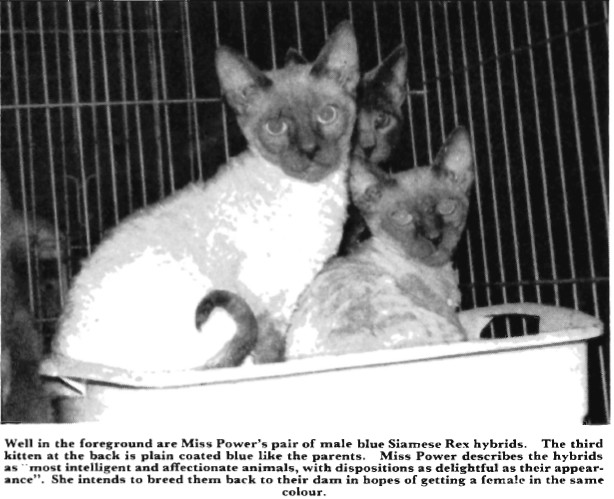

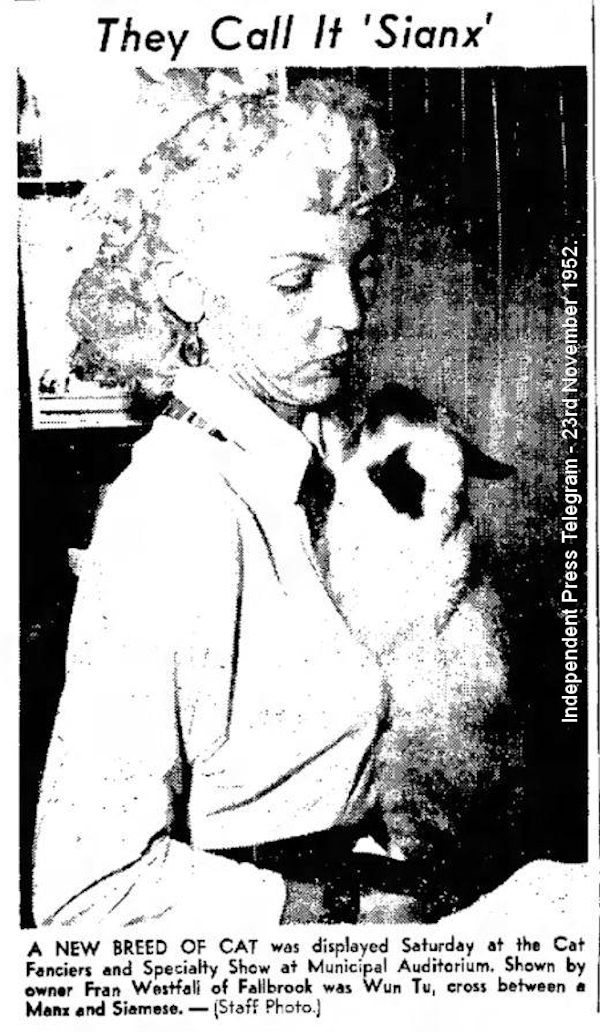 In others the prefix "Si" is used e.g. the Si-Rex is a colourpointed Rex and is further identified as Cornish Si-Rex or Devon Si-Rex. It exists unofficially or experimentally in a few breeds e.g. Si-Manx (Manxamese). In the American "Cats Magazine" of June 1965 there was a photo of two Blue-Point rex-coated kittens born to a blue self (Cornish) Rex in August 1964. Their pedigree showed that four generations back, there had been a Blue Point Siamese outcross in the breeding program. In addition, one ancestor was an Oregon Rex mutation owned by Mrs Mildred Stringham of Warrenton, Oregon. A Si-Rex was being developed in England at the same time, by Mrs Ashford (Annelida prefix).
In others the prefix "Si" is used e.g. the Si-Rex is a colourpointed Rex and is further identified as Cornish Si-Rex or Devon Si-Rex. It exists unofficially or experimentally in a few breeds e.g. Si-Manx (Manxamese). In the American "Cats Magazine" of June 1965 there was a photo of two Blue-Point rex-coated kittens born to a blue self (Cornish) Rex in August 1964. Their pedigree showed that four generations back, there had been a Blue Point Siamese outcross in the breeding program. In addition, one ancestor was an Oregon Rex mutation owned by Mrs Mildred Stringham of Warrenton, Oregon. A Si-Rex was being developed in England at the same time, by Mrs Ashford (Annelida prefix).
At a Feline Fantasy staged by the Silvergate Cat Club of San Diego, USA. in 1952, a "Sianx" cat was exhibited. This was a Siamese-Manx cross with Seal Point colour and type, sans tail. However, the Western province Cat Club of Cape Town claimed precedence in Sia-Manx breeding. The late Father Fowler's Sia-Manx was exhibited at their show during 1952, some months before the cat at the San Diego show, and resembled a Siamese Seal Point with definitely high hind quarters and complete absence of tail. He was described as a very charming person by Miss P. Ashby-Spilhaus, the Registrar of the South African Cat Union.
Below are some non-pedigree colourpoints. Capi ("Paws") is a male Siamese mix who resembles a Snowshoe. He was photographed by Koraljka Polack on Cherso island (north Adriatic sea) in 2007. There are several "Siamese mongrels" in the area due to a Siamese cat that lived in the area some years ago. This bred with stray and feral cats. The third photo is a random-bred male colourpoint.
|
|
The colourpoint trait can be introduced into any breed by crossing it with an existing colourpoint breed, although the first generation kittens will not show the trait. The gene for colourpoint has also entered the gene pool of free-breeding cats and there are many pretty "look-alikes" to be found in shelters and humane societies. Although not registrable as Siamese, Himalayan etc, they are still good pets and can be shown in household pet classes.
|
|
An unexpected colourpoint (tabby point) kitten born among a litter of black-and-white bicolours. The mother was a non-pedigree and the father was suspected of being a Birman cat that lived in the area. |
|
